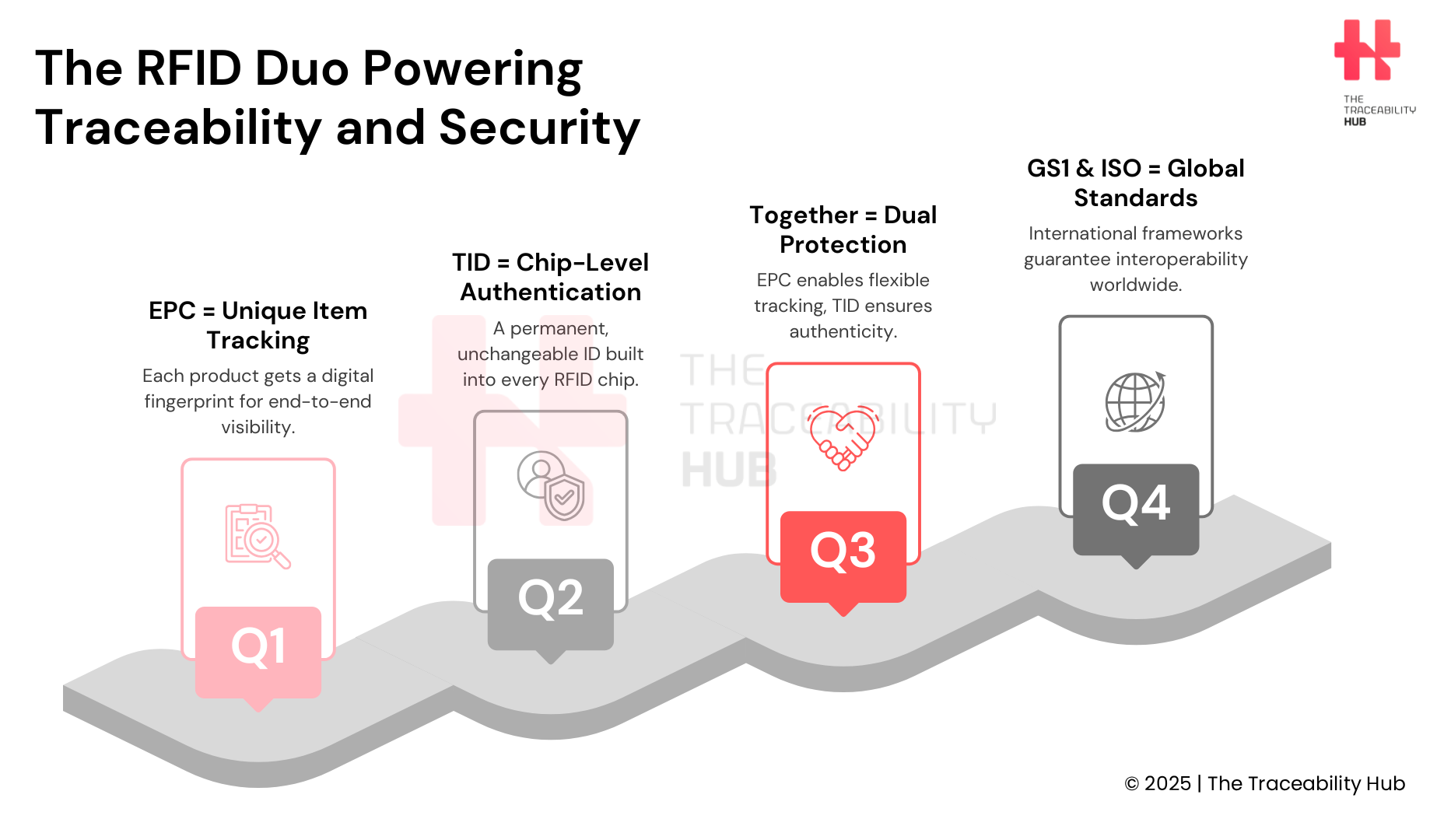EPC codes serve as unique identifiers for every physical object through a standardized identification system in RFID technology.
EPC stands in fact for “Electronic Product Codes”: they are unique identifiers for physical objects, designed to enhance tracking and management in supply chains, particularly through RFID technology.
These Electronic Product Code identifiers act as digital fingerprints that track products moving through supply chains and manage them throughout their lifecycle.
EPC RFID systems deliver significant advantages like global uniqueness and item-level identification that merge physical products with digital systems.
Logistics companies, retailers, and inventory managers value EPC tags’ rewritable nature, which makes them perfect for product monitoring. The system’s tracking capabilities help retailers monitor stock levels live and handle replenishment automatically to prevent stockouts or excess inventory.
These codes, available in 96-bit or 128-bit formats based on specific needs, are the foundations of modern supply chain visibility and product verification.
Understanding EPC and TID in RFID Systems
Radio Frequency Identification (RFID) systems depend on two essential identification components: the Electronic Product Code (EPC) and the Tag Identifier (TID). These elements play unique yet complementary roles in the RFID ecosystem and are the foundations of modern tracking and authentication solutions.
EPC Code Meaning and Purpose in RFID
The Electronic Product Code (EPC) acts as a universal identifier that gives physical objects their unique digital identity worldwide. The Auto-ID Center at MIT created this system, and GS1 has managed to keep it running. This standardized identification system does more than traditional barcodes that just identify product categories.
EPC codes can identify individual product instances, unlike regular barcodes. To cite an instance, a standard barcode might identify “a 500ml Coca-Cola bottle”, but an EPC code can tell this specific bottle apart from millions of others. This precise item-level identification makes EPC codes crucial to advanced supply chain management.
UHF Gen2 RFID tags store these identifiers in their EPC memory bank (MB01), typically using 96 to 128 bits, with room for expansion.
The EPC’s value comes from knowing how to:
- Create global uniqueness across supply chains
- Track items individually
- Connect physical products with digital systems
- See products in immediate visibility throughout their lifecycle
The EPC syntax works with many existing coding schemes while creating new ones when needed.
Each coding scheme in the EPC framework uses namespace indicators that help different systems work together.
TID as a Hardware-Level Identifier
The Tag Identifier (TID) is different from the EPC. Both provide unique identification, but the TID exists as an unchangeable code within RFID tag chips. Chip manufacturers write this hardware-level identifier during production, and nobody can change it afterward.
The TID memory bank must have:
- A 1-byte ISO 15693 class identifier (E2h)
- An XTID indicator bit that shows if the tag uses Extended Tag Identification
- A security indicator bit revealing Authenticate/Challenge command support
- A file indicator bit showing FileOpen command support
- A 9-bit Mask-Designer ID showing the manufacturer
- A 9-bit Tag Model Number revealing the chip type
Most UHF Gen2 RFID chips that follow the GS1 EPC Gen2 Tag Data Standard come with an Extended TID. This includes a unique serial number that identifies the specific UHF RFID chip. The TID’s unchangeable nature makes it perfect for authentication since nobody can copy or tamper with it.
How EPC and TID Work Together in EPC RFID Tags
EPC and TID create a powerful combination in EPC RFID tags. The TID provides the physical tag’s permanent identity, while the EPC offers a flexible, programmable identifier for the attached item.
This combination enables advanced security and tracking applications. To name just one example, see how systems can check if tags are genuine by comparing TIDs with EPCs.
RFID Journal explains this security feature: “A sophisticated organized crime group might counterfeit high-end handbags and write EPCs similar to legitimate ones, but the TIDs would reveal the deception since they wouldn’t match records of transponders used by the manufacturer”.
This two-layer identification system works greatly in supply chain applications where security and flexibility matter equally. Supply chains use TIDs to guarantee uniqueness while EPC codes update product details like production batches and storage locations dynamically.
These two identification systems may serve different purposes, but together they create a strong framework. This setup balances hardware-level security benefits with the advantages of programmable product codes.
The RFID Duo Powering Traceability and Security

EPC and TID Code Structures Explained
The structure of Electronic Product Code and Tag Identifier codes shows how these digital identifiers power sophisticated tracking and authentication systems in RFID technology. Their well-laid-out architectures have specific segments that provide vital information about products and tags.
EPC Structure: Header, Manager Code, Object Class, Serial Number
GS1 is a neutral, global no-profit collaboration platform that brings industry leaders, government, regulators, academia, and associations together to develop standards-based solutions to address the challenges of data exchange.
GS1 developed the EPC code with a standardized structure that splits into four significant segments.
The Header shows the EPC version number and encoding scheme.
The Manager Code uniquely identifies an organization or company.
EPC global assigns these codes to give companies distinctive identifiers.
The Object Class details product type, category, or model. This helps distinguish different products from the same company.
The Serial Number uniquely identifies each product. This means even similar product types will have unique EPC codes.
Common EPC Formats: SGTIN-96, SSCC-96
SGTIN-96 (Serialized Global Trade Item Number) leads as the most accessible EPC encoding scheme.
The “96” shows the 96-bit length of the final EPC binary form.
This offers the right balance between data capacity and tag memory needs.
Retail applications use SGTIN-96 most often for global trade items.
It has a 3-bit header, a 20-bit company prefix, a 24-bit merchandise reference, and a 38-bit serial number, adding up to 96 bits.
SSCC-96 (Serial Shipping Container Code) works differently.
Transportation and logistics units use this format. It has header and serial portions in the same 96-bit framework but works better for tracking shipping containers instead of retail items.
TID Structure: Manufacturer ID, Chip Model, Serial Number
Tag Identifier structure is different from EPC codes. TID memory must have a 1-byte ISO 15693 class identifier (E2h), indicator bits for Extended TID (XTID), security functions, file operations, a 9-bit Mask-Designer ID (MDID) for the manufacturer, and a 9-bit Tag Model Number for the chip type.
Most UHF RFID chips following GS1 EPC Gen2 standards have an Extended TID with a unique serial number. Manufacturers permanently assign this during production. This design gives each RFID chip an unalterable identity. Experts call it a “digital fingerprint” for the tag.
Encoding Lengths: 96-bit EPC vs 64-bit TID
EPC codes come in three options: 64-bit, 96-bit or 128-bit, based on application needs. The 96-bit version stands as the industry standard. It balances unique combinations with reasonable memory needs and can identify trillions of items. Most commercial applications can use this without needing high-memory RFID tags.
TID encoding lengths change based on manufacturer specifications and chip types. Common TID formats are 32-bit, 48-bit, or 64-bit structures.
TID requirements depend on security considerations rather than item-level identification needs. High-security applications use longer TID codes where authentication needs are stricter.
These well-designed code formats create a reliable system. EPCs handle dynamic product identification while TIDs provide hardware-level authentication. Together, they are the foundations for advanced tracking and security applications in supply chains worldwide.
Key Differences Between EPC and TID
Electronic Product Code and Tag Identifier share space on the same RFID tag but serve completely different purposes. Their design and implementation show clear contrasts that affect how each code works in RFID systems.
Modifiability: Rewritable EPC vs Fixed TID
The biggest difference between these code types lies in how you can modify them. EPC codes live in the RFID tag’s user area, and you can rewrite them anytime. This gives companies plenty of flexibility to use them in many ways.
They can update EPC codes as products move through their lifecycle to match supply chain needs. To cite an instance, stores might change the EPC number when products move from warehouse shelves to retail floors.
TID codes work differently. They represent the chip’s unchangeable properties. The tag manufacturer writes the TID during production and locks it permanently. Nobody can alter it after that.
Security Implications of Immutable Tag Identifier
TID’s unchangeable nature offers great security benefits. Since nobody can change TID after manufacturing, tags become much harder to copy or tamper with.
This makes TID especially valuable to authenticate products and verify if tags are genuine.
In spite of that, the security isn’t perfect. GS1 points out that “an adversary with sufficient resources might be able to make his own tag that has a writable TID.” This means TID serial numbers can’t guarantee absolute authentication. The system still works well to detect tag replacements, which helps in sensitive applications.
Application Fields: EPC Tracking vs Anti-Counterfeiting
These technical differences create natural specializations.
EPC RFID technology shines in logistics, retail, and inventory management where information needs to change often.
EPC tags let you track items accurately through supply chains because you can reprogram them at different stages.
EPC tracking shows where products are, how they move, and their status – perfect to manage inventory and streamline operations.
TID’s main value shows up in high-security situations that need reliable authentication. Luxury brands, drug companies, and electronics makers use TID to fight counterfeiting. The chip’s unique signature helps identify real products.
TID also helps manage assets where stopping unauthorized copies matters more than tracking changing information.
Both codes ended up working together well. EPC offers flexible item tracking while Tag Identifier provides hardware-level authentication. This creates a two-layer system that balances flexibility with security needs.
Advantages of EPC for Dynamic Tracking
EPC codes show their true value through dynamic tracking capabilities. These digital identifiers improve operations in businesses of all sizes by going beyond simple item-level identification.
Real-Time Inventory with EPC Tags
EPC tags give unprecedented visibility into inventory status without needing direct line-of-sight scanning in warehouses and retail spaces. This feature improves cycle-count accuracy, which reduces out-of-stock situations and inventory shrinkage. RFID technology helps warehouse staff locate products easily, so they know exactly when to restock.
Warehouse retailers who use EPC RFID systems see significant improvements in their inventory control at pallet and rack locations. The original return on RFID investment comes from saved work hours that staff previously spent looking for lost or misplaced inventory.
Batch Management and Supply Chain Traceability
EPC tracking changes batch management by tracking products completely through the supply chain. Products can be monitored from manufacturer to distributor to retailer. This feature becomes crucial for pharmaceuticals and food production, or wherever safety and quality standards are strict.
The EPC number on each batch makes it easy to spot quality issues quickly. Teams can identify and retrieve affected batches faster during recalls, which improves the whole process. This detailed tracking helps manufacturers prevent counterfeiting and quality issues as products move through production and distribution.
Integration with EPC Barcode Systems
EPC barcode integration creates powerful hybrid systems that combine the best of both technologies. Unlike regular barcodes that only identify product categories, EPC codes can track individual items. This unified approach works with barcode systems to support omni-channel fulfillment, letting organizations distribute customer orders through multiple channels.
This setup automates processes that once needed manual work. To cite an instance, cases and cartons with RFID tags using GS1 Standards process automatically for accuracy, which lets trading partners share exact information throughout the supply chain.
EPC codes are the foundations of modern inventory systems that bring efficiency and security to global supply chains.
TID for Authentication and Security
Tag Identifier (TID) is key for security applications in RFID systems. The growing counterfeiting concerns in various industries have made TID’s unique attributes valuable authentication solutions along with EPC codes.
Anti-Counterfeiting with Unique TID
TID’s immutable nature makes it valuable for anti-counterfeiting efforts. TID creates an unalterable digital signature because it remains permanently locked during manufacturing, unlike EPC tags that can be reprogrammed.
Luxury goods brands have embraced this feature by embedding RFID chips with unique TIDs into their products. Their customers can verify product authenticity through dedicated applications that check TIDs against secure databases.
Tag Identifier verification helps curb the illicit tobacco market that represents about 15% of the UK’s total $20 billion tobacco market.
Counterfeits make up more than half of these illicit cigarettes, which shows why these authentication systems are crucial.
Use in Access Control and Asset Verification
Organizations use TID’s hardware-level identification in access control and asset verification systems. TID checks allow only authorized personnel to access sensitive areas or equipment. This approach blocks unauthorized reading and access to protect user information and transaction data.
Systems can read both EPC and TID numbers at once and verify these combinations against approved databases for asset verification. This dual-verification process confirms that tags and their identified items remain untampered.
ISO 18000-6C and ISO 14443 Compliance
TID security implementations rely on industry protocols as their framework. The ISO 18000-6C protocol (also known as EPC global Gen2) works in the ultra-high frequency (UHF) range between 860-960 MHz with distances up to 10 meters. Data transmits at high speeds with strong resistance to environmental interference through this standard.
ISO 14443 handles shorter-range applications within 10cm. This high-frequency (HF) standard includes encryption technology for high-security protection. Payment systems, transportation cards, and institutional access control commonly use this standard.
These standards enable TID to work as a reliable security mechanism along with the tracking capabilities of EPC RFID systems.
EPC Tracking with TID Authentication: A Foundation for Efficient Management
EPC and Tag Identifier codes are the foundations of modern RFID technology. They play different but complementary roles in global supply chains.
EPC codes shine at providing dynamic, item-level identification that reshapes the scene of inventory management through live tracking capabilities.
These rewritable identifiers help businesses monitor products throughout their lifecycle and improve visibility and operational efficiency.
They also adapt easily to changing requirements as products move from manufacturer to consumer.
Tag Identifier codes work as permanent digital signatures that manufacturers embed during production. Their unchangeable nature makes them especially valuable to authenticate products and curb counterfeiting in luxury goods and pharmaceuticals.
TID’s hardware-level security provides product verification that EPC codes can’t match alone.
The partnership between these identification systems creates a strong framework that balances flexibility with security. Retailers can optimize inventory processes with EPC’s capabilities while using TID’s authentication to verify product authenticity.
Though different in structure and use, both systems follow international standards for global compatibility.
Companies that use these technologies gain many advantages. They see fewer inventory mistakes, better traceability, improved security, and optimized operations. Supply chains keep getting more complex, and combining Electronic Product Code tracking with TID authentication creates a foundation for efficient management and strong security protocols. These sophisticated identification systems help organizations thrive in today’s connected marketplace while protecting their brand’s integrity and customer trust.
Read more: Future-Proofing Supply Chains: The Technology Framework for 2025 and Beyond






